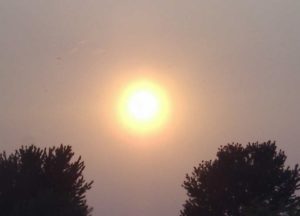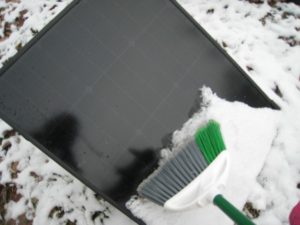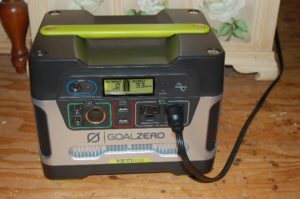Solar Power in the Winter
Can you use solar power in the winter?
I get asked this question a lot, since I’m on solar power that’s totally off the grid. The answer is absolutely. In fact, I’m powering my computer to write this post right now with my solar batteries on a cold and snowy day without a single glimpse of sun in the sky. I live in Upstate NY where we get a ton of snow, and only a few sunny days a month during the winter season. But I’m still able to power my life with my solar. However, solar power in the winter does come with a little extra effort to ensure you get the most out of it.
Catch the Early Morning Sun
The first thing you’ll want to do is make sure that your panels are plugged into your batteries all the time if possible. The sun seems to shine most frequently in the early mornings in the winter. As such, you’ll want to be sure those panels are setup and ready to start sucking in the wattage, even if you’re not out of bed yet.
 When I initially started with solar, I had a very small setup, one panel and one battery, which was enough to power a few things here and there. So “back in those days” (ok, so it was just last November), it was no problem to store my panel and battery inside and then bring them outside when the sun was shining to charge up. Since I started running the rest of my life on solar, however, I got more batteries, and therefore needed more sun.
When I initially started with solar, I had a very small setup, one panel and one battery, which was enough to power a few things here and there. So “back in those days” (ok, so it was just last November), it was no problem to store my panel and battery inside and then bring them outside when the sun was shining to charge up. Since I started running the rest of my life on solar, however, I got more batteries, and therefore needed more sun.
So I now have the batteries stored safely inside. They’re connected by cord to the solar panels which are outside soaking up the sun even while I’m sleeping. The batteries have an auto-on function that lets them start sucking in power as soon as the sun is high enough to hit them. That way I don’t have to be up at the crack of dawn to plug them in every morning to catch that early sun. (I’m a flower farmer, not a dairy farmer, thus I am not a morning person). Plus I don’t have to haul 3 panels and 3 batteries in and out of the house all the time (one of them is really heavy). I just leave them and let them do their thing, pulling in the power of the sun.
Keep the Panels Dusted Off
In the summer month, there’s almost no maintenance on the panels. Besides the fact that there’s continuous hours of sunlight for them to bathe in, there’s also no need to clean them. Any dust that gets on the panels washes itself off after a rain shower or two. In fact the only maintenance I’ve had to do on my panels in the summer is washing the muddy footprints off of them where the squirrels like to play on them. (Yes, seriously, this is a real problem that most people don’t think of when they think about going solar).
 On the flip side, if you live in a cold climate in the winter like me, the odds are, you’re going to have to dust the snow off those panels every now and again if you want to use your solar power in the winter. After a big snow storm, you literally have to dig out the panels. Even just a light dusting will prevent them from sucking in the sun.
On the flip side, if you live in a cold climate in the winter like me, the odds are, you’re going to have to dust the snow off those panels every now and again if you want to use your solar power in the winter. After a big snow storm, you literally have to dig out the panels. Even just a light dusting will prevent them from sucking in the sun.
Being black, the solar panels will eventually melt themselves off when the sun hits them. But they’ll start working faster if you give them a hand. On cloudy days, the snow may not even melt at all, preventing your panels from pulling in the “cloud sun” watts. So be sure to keep those panels free of snow to absorb as much power from those cloudy winter skies as possible. And yes, they pull in solar power even in completely cloudy skies.
Position Them Toward the Sun
This one’s kind of a no-brainer, but it’s true. In the winter, the sun is at a much different angle than in the summer. As such, you may need to position your panels accordingly. If they’re fastened to your roof, you can’t do much about it. But if you have a simple setup like mine, you can physically move your panels wherever you want (within reach of your cord of course) to get the best possible sun angle.
My place is in the woods (yeah, I know, great location for solar right). So I have to change the position at different times of the year to catch the sun depending on how full the trees are. I also alter them depending on what angle the sun is facing. Even on fully cloudy days, the panels still know where the sun is. If you have them facing wherever it is buried under those winter clouds, they’ll suck in more watts than if they’re facing a bad direction. Always position them toward the sun when possible.
Insulate the Batteries
 If you’re in a conventional house that’s heated with conventional methods and just using solar as an adjunct to your other power, then you probably don’t have to worry about this step. However, if you’re a winter camper or living off the grid, you’re likely to have your batteries exposed to long periods of cold. So you’ll want to insulate them to keep them in good working order. The cold will definitely decrease the length of use (I’m speaking from experience).
If you’re in a conventional house that’s heated with conventional methods and just using solar as an adjunct to your other power, then you probably don’t have to worry about this step. However, if you’re a winter camper or living off the grid, you’re likely to have your batteries exposed to long periods of cold. So you’ll want to insulate them to keep them in good working order. The cold will definitely decrease the length of use (I’m speaking from experience).
Being off the grid, my place can get quite cold, so I did have to insulate my batteries. Goal Zero, the company that I got my solar equipment from, recommends putting the batteries in an insulated cooler, as the small amount of heat created by the batteries when they’re plugged into the sun or being used will keep them warm enough. Not having an insulated cooler available, I just used one of my quilts to lay over them and keep them warm. I definitely noticed a big difference with how fast the batteries drained. I have power for much longer in each battery with the blanket than without.
Thinking about going solar yourself, but want to start small? Try the Yeti 400 and Boulder 50 combo. That’s what I started with and have been in love with solar ever since. Just be careful, side effects may include: deciding to purchase more solar batteries and panels to power everything in your life, becoming more energy conscious, and making the planet a greener place. 
Solar Power in the winter – by Amber Reifsteck, The Woodland Elf
The information provided on this website is for general information purposes only. If you choose to rely on the information on this website, you do so at your own risk and you assume responsibility for the results. (Full disclaimer here)
Enjoy this post? Click here to subscribe by email and get new posts delivered to your inbox.Ads by Google










